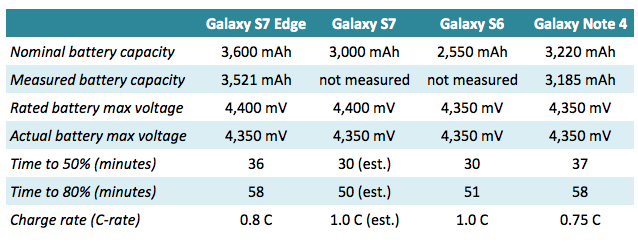CHARGING THE SAMSUNG GALAXY S7 EDGE

The new Galaxy S7 and its sister smartphone the S7 Edge are receiving rave reviews. So let’s take a look at their batteries. A brief comparison table shows the new S7 and S7 Edge side-by-side with the older S6 and the Note 4.

Let’s make a few key observations starting with the charge rate and charging time. The S7 and S7 Edge use a maximum measured charging current of 3A, which works out to charging rate of 0.8 C (3/3.6) for the S7 Edge and 1.0 C for the S7. The charge times to 80% are 58 and 50 minutes respectively. That’s faster than any iPhone, present or past, that typically charge at a rate of about 0.7 C. This earlier post explains the meaning of charge rate. We didn’t measure the battery capacity of the S7 but that of the S7 Edge came in at 3,521 mAh, fairly close to the advertised capacity of 3,600 mAh — that’s a nice hefty capacity that should last at least one full day.

The S7 and S7 Edge are using batteries with a higher nominal maximum charge voltage of 4.4V compared to the older 4.35V standard. See the photo below. Surprisingly, teardowns of the S7 and S7 Edge (US models) show that these batteries come from ATL, not from Samsung’s battery division, Samsung SDI.
Battery vendors are now increasing the maximum charge voltage to 4.4V to raise the energy density of the battery by an additional 5%. However, both S7 and S7 Edge do not charge to this maximum voltage — instead, they charge the battery to only 4.35V. The green curve in the charging chart above shows the maximum voltage of 4.35V (not 4.4V) at the end of the charge cycle. This means that the battery true capacity is actually 5% higher…in other words, the S7 Edge has an intrinsic battery capacity that is near 3,700 mAh, but Samsung is instead choosing to operate it at 3,521 mAh.
Is it confusing enough? So why would Samsung sacrifice this additional capacity and not mention it in the capacity label on the battery? There are several reasons. First, it is quite likely that the swelling of this battery is severe at 4.4V that it limits Samsung’s quest to build thin smartphones. By reducing the voltage to 4.35V, the effects of swelling are somewhat mitigated. Second, the S7 and S7 Edge are both running at a fast charge rate. We observed in a previous post that the older Galaxy Note 4 suffered from a poor cycle life problem due to fast charging — the battery died within less than a year of operation. Reducing the voltage to 4.35V mitigates some of these cycle life problems, of course at the expense of a loss in capacity.
An astute reader might say: “Well, 3,600 mAh is plenty capacity for me!” That might be true, but you are paying for a bigger battery and using a physically larger battery than you need. It’s a compromise! The point here is to illustrate these increasingly difficult compromises that Samsung had to go through when it came to the battery.
I think for now, I might want to stick with Sony Xperia X’s battery — that’s a battery I know I can rely on.

